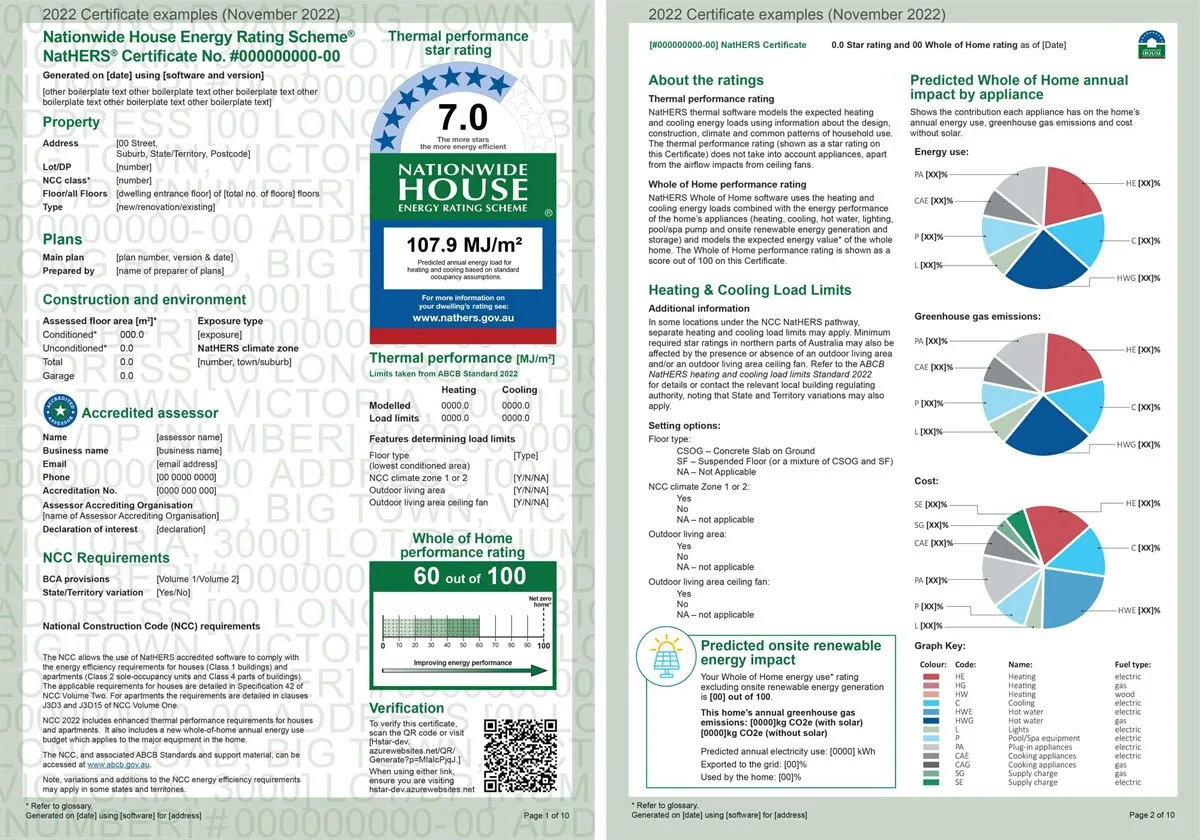What is a NatHERS Certificate? What is a star rating?
A Simple Guide to Home Energy Efficiency Reports
You’ve probably come across the term “7-star home”
But what does that NatHERS star rating actually mean? What are NatHERS Certificates? And why are home energy assessments becoming a bigger part of how we design, build, and value houses in Australia?
The NatHERS system, short for the Nationwide House Energy Rating Scheme, can sound technical and dry, but at its heart, it's about something very human: how comfortable a home feels to live in, and how much energy it takes to keep it that way.
Home energy ratings matter, not just for compliance, but because they help us make better design choices in a project. When a home is well-oriented, well-insulated, and thoughtfully designed, it’s often more comfortable, cheaper to run, less reliant on heating and cooling systems and can attract a better resale value. That’s good for households, good for the energy grid, and a step in the right direction for the planet.
In this article, we’ll unpack what NatHERS star ratings actually measure, how to get an energy assessment, what the results mean for your home or design, and why they’re only one part of the sustainability picture.
NatHERS Ratings Explained
A NatHERS star rating is Australia’s main tool for estimating how much energy a home will need for heating and cooling in order to maintain a standard level of comfort throughout the year. It’s the most common way to show that a new home or major renovation meets the minimum energy efficiency requirements set out in the National Construction Code (NCC) – something that’s essential for gaining building approval.
These requirements have recently changed in many states and territories. Victoria, South Australia and Western Australia now require a minimum 7-star NatHERS rating be achieved. You can check your local requirements and adoption dates here.
A home’s rating, out of 10 stars, is calculated using specialist software that models how the building will perform across the seasons. It considers hundreds of factors, including design, layout, orientation, insulation, construction materials, window details, and the local climate.
Australia’s climate is incredibly diverse, from hot, humid tropics to alpine regions and everything in between. That means energy-efficient design can look very different depending on location, and NatHERS software takes this into account so that ratings are comparable across the country. A 7-star home in Victoria will look different from a 7-star home in Queensland, but both aim to deliver the same standard of comfort and performance for their local conditions.
Image: Example NatHERS Certificate, showing a 7-star thermal performance rating and 60/100 Whole of Home score.
You’ll notice on the sample NatHERS certificate above that in addition to the NatHERS star rating, there's also a Whole of Home score (out of 100). This rating is now a mandatory compliance requirement in many states. While the star rating reflects the thermal performance of the home, the Whole of Home score accounts for the energy performance of appliances like the hot water system, lighting, heating and cooling systems, cooking, and pool or spa equipment. It also factors in any solar energy generation and battery storage. (We’ll explore Whole of Home in more detail in a separate article.)
Tip: For more information, you can watch a video explaining NatHERS ratings here.
Getting a Home Energy Assessment
To get a NatHERS star rating, you’ll need to engage a NatHERS Accredited Assessor (energy consultant), like Zone Zero, someone trained in thermal performance modelling using accredited software. Working with an accredited assessor ensures your rating is accurate, compliant, and recognised by regulatory authorities. Assessors follow a national code of conduct and are subject to ongoing quality assurance, so you can trust the result reflects how the home is likely to perform.
At Zone Zero, our NatHERS assessment and certification process helps ensure your design reaches 7 stars and beyond.
If you're preparing for a home energy assessment, it helps to be organised early. We’ve created a NatHERS Rating Documentation Checklist to help streamline your sustainability assessment. Contact us for a copy.
Tip: The earlier you engage an energy consultant in the design process, the more opportunity there is to improve the performance of the home in simple, low-cost ways. Moving through the design process without testing and optimisation, runs the risk of costly additions to the project down the track when compliance comes around.
Zone Zero offers Environmentally Sustainable Design (ESD) Consultancy for any stage of the design, working with architects, designers or homeowners directly, to help guide decision making and ensure your project achieves the best possible outcome.
The Future of NatHERS Energy Ratings in Australia
Beyond building approvals, NatHERS is starting to play a bigger role in how we value and finance homes. The system is already being used by the finance sector to support green home loans, which help incentivise homes that perform above minimum standards. It may also contribute to rental standards and energy performance disclosure frameworks, helping drive improvements in comfort, efficiency, and affordability across the housing market.
Australia isn’t alone in this shift many countries, particularly in Europe and the UK, already use energy ratings to regulate rental standards, guide property sales, and support access to finance. These international models show how energy performance can become a more visible and valued part of the housing market.
Work is underway to expand the NatHERS framework to cover existing homes, not just new builds. This would allow energy ratings to be used more broadly for upgrades, sales, and policy-making.
The expansion is building on tools like Victorian Scorecard and RapidRate, which already assess existing homes, with a national rollout expected from mid-2025.
By making energy performance more transparent and actionable, NatHERS is well-positioned to influence not just how we design homes, but how we live in and invest in them too.
Why a NatHERS Star Rating Certificate Isn’t the Full Picture of a Home’s Sustainability
While a NatHERS certificate gives valuable insight into a home’s thermal performance, it doesn’t tell the whole story.
It doesn’t account for where building materials come from, how they’re processed, or how much energy goes into extracting or manufacturing them - or whether they’re recycled. It doesn’t consider water storage or efficiency. It doesn’t assess the quality of design and construction for long-term adaptability, or the durability of materials and craftsmanship over time.
Significantly, it also doesn’t take into account whether a home is simply larger than it needs to be. (New homes in Australia remain some of the largest in the world.) Nor does it reflect the broader environmental impacts of construction, such as land use, transport, and waste.
So while NatHERS energy ratings can help guide the design of a more comfortable and energy-efficient home, it’s still just one piece of the puzzle. True sustainability comes from conscious choices across every stage of the process, from design and construction choices, to the way we live in and care for our homes.
Still, it’s a useful tool, and it’s helping to raise the baseline standard for energy performance in Australian housing. It’s a step in the right direction, and one that opens up important conversations about building better.
Designing With Intention
As the housing industry shifts toward higher standards and better outcomes, tools like NatHERS have an important role to play, not just in meeting compliance, but in designing homes that are more comfortable, efficient, and adaptable to the future.
The real value comes when we treat energy ratings as a guide, not a box to tick, but a starting point for thoughtful, sustainable design.








